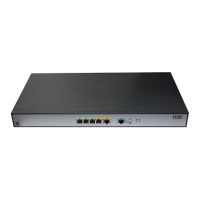63
queue. The idle duration increases as the AIFSN value increases (see Figure 28 for the AIFS
durations).
• Exponent form of CWmin (ECWmin) and exponent form of CWmax
(ECWmax)—Determine the average backoff slots, which increases as the two values increase
(see Figure 28 for the ba
ckoff slots).
• Transmission opportunity limit (TXOPLimit)—Indicates the maximum time for which a user
can hold a channel after a successful contention. The greater the TXOPLimit is, the longer the
user can hold the channel. The value 0 indicates that the user can send only one packet each
time it holds the channel.
Figure 28 Per-AC channel contention parameters in WMM
CAC admission policies
CAC requires that a client obtain permission of the AP before it can use a high-priority AC queue for
transmission, guaranteeing bandwidth to the clients that have gained access. CAC controls real time
traffic (AC-VO and AC-VI traffic) but not common data traffic (AC-BE and AC-BK traffic).
If a client wants to use a high-priority AC queue, it must send a request to the AP. The AP returns a
positive or negative response based on either of the following admission control policies:
• Channel utilization-based admission policy—The AP calculates the total time that the
existing high-priority AC queues occupy the channel in one second, and then calculates the
time that the requesting traffic will occupy the channel in one second. If the sum of the two
values is smaller than or equal to the maximum hold time of the channel, the client can use the
requested AC queue. Otherwise, the request is rejected.
• Users-based admission policy—If the number of clients using high-priority AC queues plus
the clients requesting for high-priority AC queues is smaller than or equal to the maximum
number of high-priority AC queue clients, the request is accepted. Otherwise, the request is
rejected. During calculation, a client is counted once even if it is using both the AC-VO and
AC-VI queues.
U-APSD power-save mechanism
U-APSD improves the 802.11 APSD power saving mechanism. When associating clients with AC
queues, you can specify some AC queues as trigger-enabled, some AC queues as delivery-enabled,
and the maximum number of data packets that can be delivered after receiving a trigger packet. Both
the trigger attribute and the delivery attribute can be modified when flows are established using CAC.
When a client sleeps, the delivery-enabled AC queue packets destined for the client are buffered.
The client must send a trigger-enabled AC queue packet to get the buffered packets. After the AP

